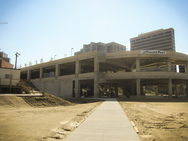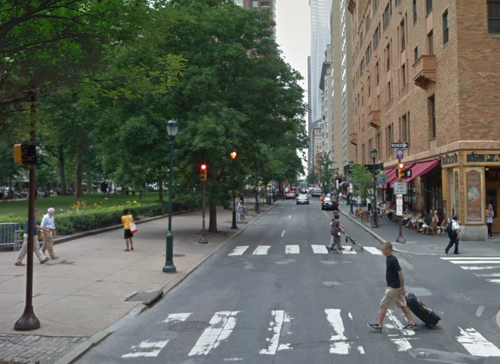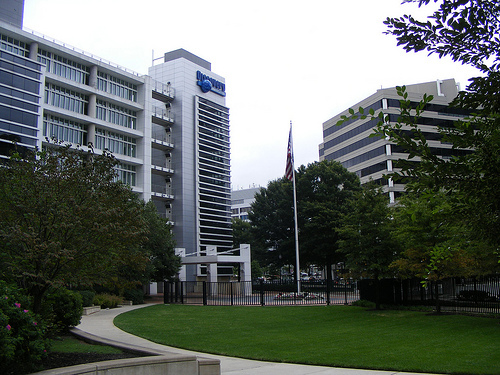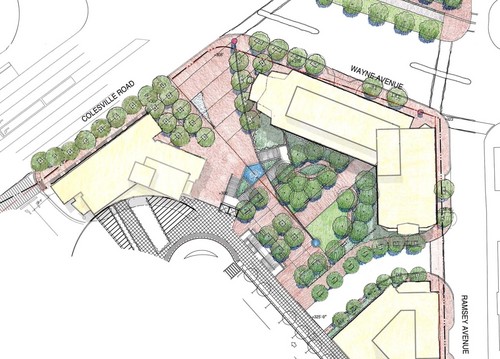It takes more than open space to make a great urban park

The unfinished Silver Spring Transit Center. Photo by thisisbossi on Flickr.
The Silver Spring Transit Center isn’t finished yet, but there’s already support for turning vacant land next to it into a big park. However, this really isn’t a good place for a park. There are also lots of small, underused parks nearby, and with some alterations, they could help quench the demand for open space.
County Councilmember Hans Riemer recently proposed building a two-acre park next to the Transit Center instead of an originally planned hotel. On his blog, he talks about the many “green urban parks” in downtown DC, like Dupont Circle. “Silver Spring deserves one too,” he writes.
What makes a great urban park like Dupont Circle, or Rittenhouse Square in Philadelphia, or Union Square in New York? They all have grassy areas and trees, and are nice places to enjoy the outdoors. But they don’t exist in isolation. What happens on the edges of great urban parks is what makes them successful.
Great urban parks need people and buildings, too
Parks like Dupont and Rittenhouse sit in the middle of very dense, busy neighborhoods with thousands of people living and working nearby. The surrounding buildings also create a frame around the space, making it an outdoor room. Most of the buildings that face Dupont Circle have a store or restaurant on the ground floor. On Rittenhouse Square, there are apartment building entrances and restaurants with dining terraces opening to the square.

What happens on the edges of Rittenhouse Square make it a great park. Photo from Google Street View.
Together, these things make a space that people are constantly using throughout the day, eating lunch, playing chess, making music, holding demonstrations, getting exercise, or just passing through.
Compare that to the Transit Center. Most of the surrounding buildings don’t face the space Hans Riemer would like to be a park. At the street level, all you’ll find are fast-food places, lots of blank walls, and loading docks, none of which do much to generate life on the sidewalk. Putting a park here wouldn’t change that context.
We know that because there used to be a park next to the Metro station before the Transit Center was built. It was a popular skate spot, but it was also run-down and empty. It wasn’t a good park.
It would be different if we could build a park with shops and restaurants directly facing it, and lots of people in very, very close proximity to use it and pass through it all the time. In fact, that’s what the Transit Center plans already call for: a smaller park, less than an acre in size but with some green areas, directly adjacent to an apartment building, an office building, and a hotel.
Unfortunately, those plans are on hold due to a breakdown in negotiations between developer Foulger-Pratt, which also built the Transit Center, and Metro, which owns the land. But that doesn’t mean we should throw them away.
Silver Spring has lots of open space, but we don’t use it
People complain that Silver Spring doesn’t have enough parks, but we might actually have too many. In downtown Silver Spring, there are literally dozens of small pocket parks, the result of a requirement that new development include an open space that’s accessible to the public.
Many of those spaces are poorly designed and go unused. County planners and residents have already been working to fix this problem.
In 2008, the Planning Board recommended eliminating the pocket park requirement and build big parks instead. Two such projects have already been approved. The redevelopment of the Blairs will include a big park, while the Studio Plaza development on Fenton Street will have one as well.
And last year, the Silver Spring Citizens Advisory Board suggested looking at ways to repurpose existing parks and county-owned properties. Evan Glass, chair of the board and a candidate for County Council, has proposed reusing the current Silver Spring Library as a recreation center and park space once the new library is built.

There’s a big, grassy park a block from the Transit Center, but it goes unused. Photo by the author.
Some of downtown’s pocket parks could be repurposed as well. There’s already a big, grassy park exists a block from the Transit Center at the Discovery Channel headquarters. But it isn’t really used and was closed for months after a gunman attacked the building in 2010. Across from the Transit Center, Montgomery County will turn a bus turnaround into another small park with trees and landscaping.
These spaces aren’t perfect. But they exist, and if any community member or elected official is serious about improving open space in downtown Silver Spring, they should start here.
There’s a better use for the Transit Center site
It may sound counterintuitive, but sometimes, creating great parks in urban areas means more buildings. Silver Spring needs a critical mass of people and stuff to generate the activity needed to give our streets and parks life. Meanwhile, too many bad parks have instead created big, gaping holes in our downtown, sucking out activity and life.
The Transit Center is a bad place for a big park. But it’s a good place for buildings.
Montgomery County and Maryland taxpayers have already spent upwards of $120 million on the Transit Center, on top of money spent decades ago to build the Metro station, and money we will soon spend to build the Purple Line. Where they converge will be one of the most valuable development sites in the region, and a significant opportunity to encourage transit use and generate tax revenue.
Not taking advantage of this would be a colossal waste. So would ignoring all of the open spaces Silver Spring already has, as well as the opportunities we do have to create new and better ones.


